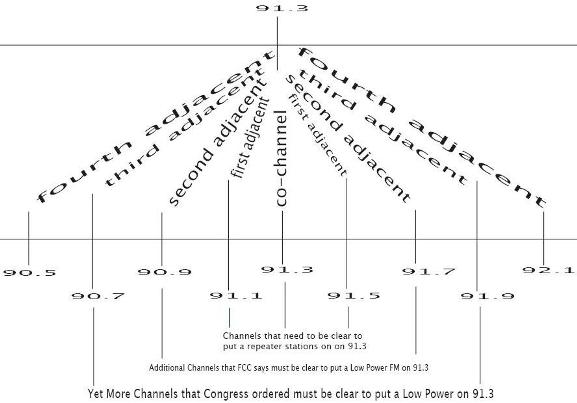The FM dial made simple
The FM band is set up in the United States so that there are a hundred channels, starting at 88.1 and ending at 107.9. They are allocated on odd decimals: it goes 88.1, 88.3, 88.5, 88.7, etc. So there is no such thing for example, as 89.4. Lets use the example of 89.1. The FCC uses the poetically titled "Minimum Distance Spacing Methodology" for allocating FM radio licenses. If there is a 6000 watt station on 89.1 (referred to as co-channel), you cannot set up a low power FM station within 67 kilometers of an existing station. If you want to set up an LPFM on 89.3 or 88.9 (known as the first adjacent channels, because they are the next channel in either direction), you cannot put a LPFM closer than 56 kilometers. If you want to put an LPFM on 89.5 or 88.7, you can not be closer than 29 kilometers. These were the original FCC rules for LPFM. Then Congress forced the FCC to add "third adjacent protection," meaning that you could not put a LPFM on either 89.7 or 88.5 closer than 29 km to an existing 89.1. Pretty dreary. There are even a few more technical details than that- IF protection, and so on. Making matters worse, those distances are for the smallest powered incumbent stations: Class A with 6000 Watts. The distances are even greater for higher power stations. For a class C (100,000 Watts) the co-channel minimum distance is 130 km, first adjacent is 120 km, the second adjacent distance is 93 km, and the new third adjacent distance is also 93 km away.
So why might it work for you to move your transmitter site? Perhaps you were disqualified by a class C station that was on a third adjacent channel 92.1 kilometers to the northeast- a station you probably never even heard, and a station that only a hallucinating congressman could imagine you would interfere with. If you simply move to your cousins' garage, 1 kilometer to the southwest, your application will be resuscitated!

